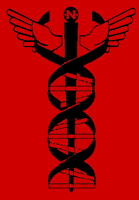

© Copyright 1998-2006, Robert A. Freitas Jr.
All rights reserved.
Nanomedicine may be defined as the monitoring, repair, construction and control of human biological systems at the molecular level, using engineered nanodevices and nanostructures.
Basic nanostructured materials, engineered enzymes, and the many products of biotechnology will be enormously useful in near-term medical applications. However, the full promise of nanomedicine is unlikely to arrive until after the development of precisely controlled or programmable medical nanomachines and nanorobots.
Such microscopic machines were first hypothesized by the Nobel-winning physicist Richard Feynman in 1959, and later were described at length by K. Eric Drexler in his popular books Engines of Creation (1986) and Unbounding the Future (1991), and in his more recent technical book Nanosystems: Molecular Machinery, Manufacturing, and Computation (1992).
Methods for designing and constructing these devices (or their most important components) are currently being actively pursued by the Institute for Molecular Manufacturing, the Laboratory for Molecular Robotics at the University of Southern California, the Center for Nanoscale Science and Technology at Rice University, the NAS Computational Molecular Nanotechnology Group at NASA/Ames Research Center, and by many other university and government organizations in the United States, Europe, and Japan, and also in the private sector by nanotechnology startup companies such as Zyvex and nanotechnology seed capital firms such as Molecular Manufacturing Enterprises Inc. (MMEI).
Once nanomachines are available, the ultimate dream of every healer, medicine man, and physician throughout recorded history will, at last, become a reality. Programmable and controllable microscale robots comprised of nanoscale parts fabricated to nanometer precision will allow medical doctors to execute curative and reconstructive procedures in the human body at the cellular and molecular levels. Nanomedical physicians of the early 21st century will still make good use of the body’s natural healing powers and homeostatic mechanisms, because, all else equal, those interventions are best that intervene least. But the ability to direct events in a controlled fashion at the cellular level is the key that will unlock the indefinite extension of human health and the expansion of human abilities.
Robert A. Freitas Jr. is currently writing Nanomedicine, the first book to comprehensively address the technical issues involved in the medical applications of molecular nanotechnology and medical nanodevice design.
Nanomedicine will be published in four volumes. The book represents a preliminary attempt to explore the full range of nanomedical applications, along with some details of the required foundational technical competencies. An established biomedical book publisher, Landes Bioscience, has been signed to produce all four volumes. Nanomedicine, Volume I, was published in October 1999 and may be ordered directly either from the publisher or from Amazon.com in the original out-of-print hardback edition or in the in-print softcover edition. Volume IIA: Biocompatibility was published by Landes Bioscience in October 2003.The anticipated publication date for Volume IIB: Systems and Operations is October 2006.
An early-version Outline, chapter summaries, and a sample chapter from Nanomedicine, Volume I, by Robert A. Freitas Jr.:
Nanomedicine can be ordered now:
Order Nanomedicine, Volume I: Basic Capabilities from Amazon.com out-of-print hardback or in-print softcover.
Volume I is available online at:: http://www.nanomedicine.com/NMI.htm
Nanomedicine, Volume I, has been reviewed by
Order Nanomedicine, Volume IIA: Biocompatibility from Amazon.com
Volume IIA is available online at: http://www.nanomedicine.com/NMIIA.htm
Nanomedicine, Volume IIA, has been reviewed by
September 2000: Frankfurter Allgemeine Zeitung (FAZ) interviews James Von Ehr II, Ralph C. Merkle, and Robert A. Freitas Jr. at Zyvex Corp., Richardson, TX, on Friday, 28 July 2000. (Article text in German)
August 2000: Interview with Freitas published by German newspaper Frankfurter Allgemeine Zeitung on 1 August 2000.
November 1999: Robert Freitas was selected by the World Technology Network as a Finalist for the World Technology Award in Materials “for his work at the Institute of Molecular Manufacturing, his recent text Nanomedicine, and his contributions to the field of nanotechnology.” The WTN website includes a brief biography of Freitas.
September 1999: An interview with Freitas appeared in Issue No. 38 of the Foresight Update.
The following nanomedicine FAQ and their answers have been compiled by Robert A. Freitas Jr.
Please visit the Nanomedicine Art Gallery. Here you will find a growing collection of historical and original visual artwork that shows how medical nanorobots and other nanomedical devices might appear.
A compilation of articles on medical nanomaterials, bionanotechnology, or “nanomedicine” from 1992 to the present. A few examples:
Nanomedicine Research: Nanomedicine Researchers (with online biographies); Nanomedicine Research, Governmental, and Commercial Organizations
You can directly support the research and writing of the Nanomedicine book series by contributing now to the IMM Freitas Research Fund.
Nanomedicine, Volume I, was published in October 1999 and may be ordered directly either from the publisher, Landes Bioscience, or from Amazon.com
Order Nanomedicine, Volume I: Basic Capabilities from Amazon.com
Nanomedicine, Volume IIA, was published in October 2003 and may be ordered directly either from the publisher, Landes Bioscience or from Amazon.com
© Copyright 1998-2006, Robert A. Freitas Jr. All rights reserved.